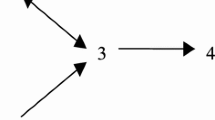Abstract
We consider a hierarchical network game with multiple links, a single service provider, and a large number of users with multiple classes, where different classes of users enter the network and exit it at different nodes. Each user is charged by the service provider a fixed price per unit of bandwidth used on each link in its route, and chooses the level of its flow by maximizing an objective function that shows a tradeoff between the disutility of the payment to the service provider and congestion cost on the link the user uses, and the utility of its flow. The service provider, on the other hand, wishes to maximize the total revenue it collects. We formulate this problem as a leader-follower (Stackelberg) game, with a single leader (the service provider, who sets the price) and a large number of Nash followers (the users, who decide on their flow rates). We show that the game admits a unique equilibrium, and obtain the solution in analytic form. A detailed study of the limiting case where the number of followers is large reveals a number of interesting and intuitive properties of the equilibrium, and answers the question of whether and when the service provider has the incentive to add additional capacity to the network in response to an increase in the number of users on a particular link.
Similar content being viewed by others
References
KELLY, F. P., MAULLOO, A., and TAN, D., Rate Control in Communication Networks: Shadow Prices, Proportional Fairness, and Stability, Journal of the Operations Research Society, Vol. 49, pp. 237–252, 1998.
GIBBENS, R. J., and KELLY, F. P., Resource Pricing and the Evolution of Congestion Control, Automatica, Vol. 35, pp. 1969–1985, 1999.
LOW, S. H., and LAPSLEY, D. E., Optimization Flow Control, I: Basic Algorithm and Convergence, IEEE/ACM Transactions on Networking, Vol. 35, pp. 861–875, 1999.
KELLY, F. P., Models for a Self-Managed Internet, Philosophical Transactions of the Royal Society, Vol. 358A, pp. 2335–2348, 2000.
KELLY, F. P., Mathematical Modelling of the Internet, Mathematics Unlimited: 2001 and Beyond, Edited by B. Engquist and W. Schmid, Springer Verlag, Berlin, Germany, pp. 685–702, 2001.
KUNNIYUR, S., and SRIKANT, R., End-to-End Congestion Control: Utility Functions, Random Losses, and ECN Marks, Proceedings of the IEEE INFOCOM, Tel Aviv, Israel, pp. 1323–1332, 2000.
KUNNIYUR, S., and SRIKANT, R., Analysis and Design of an Adaptive Virtual Queue Algorithm for Active Queue Management, Proceedings of the ACM SIGCOMM, San Diego, California, pp. 123–134, 2001.
KUNNIYUR, S., and SRIKANT, R., A Time-Scale Decomposition Approach to Adaptive ECN Marking, Proceedings of the IEEE INFOCOM, Anchorage, Alaska, pp. 1330–1339, 2001.
BOTVICH, D. D., and DUFFIELD, N. G., Large Deviations, Economies of Scale, and the Shape of the Loss Curûe in Large Multiplexers, Queueing Systems, Vol. 20, pp. 293–320, 1995.
BAşAR, T., and SRIKANT, R., Reûenue-Maximizing Pricing and Capacity Expansion in a Many-Users Regime, Proceedings of the IEEE INFOCOM, New York, NY, pp. 1556–1563, 2002.
ORDA, A., ROM, R., and SHIMKIN, N., Competitiûe Routing in Multiuser Communication Networks, IEEE/ACM Transactions on Networking, Vol. 1, pp. 510–521, 1993.
KORILIS, Y., LAZAR, A., and ORDA, A., Architecting Noncooperatiûe Networks, IEEE Journal on Selected Areas in Communications, Vol. 13, pp. 1241–1251, 1995.
LA, R. J., and ANANTHARAM, V., Optimal Routing Control: A Game Theoretic Approach, Proceedings of the 36th IEEE Conference on Decision and Control, San Diego, California, pp. 2910–2915, 1997.
ALTMAN, E., BAşAR, T., and SRIKANT, R., Nash Equilibria for Combined Flow Control and Routing in Networks: Asymptotic Behavior for a Large Number of Users, IEEE Transactions on Automatic Control, Vol. 47, pp. 917–930, 2002.
ALTMAN, E., BAşAR, T., JIMINEZ, T., and SHIMKIN, N., Competitive Routing in Networks with Polynomial Costs, IEEE Transactions on Automatic Control, Vol. 47, pp. 92–96, 2002.
BAşAR, T., and OLSDER, G. J., Dynamic Noncooperative Game Theory, Series in Classics in Applied Mathematics, SIAM, Philadelphia, Pennsylvania, 1999.
CRUZ, J. B., Jr., Leader-Follower Strategies for Multilevel Systems, IEEE Transactions on Automatic Control, Vol. 23, pp. 244–254, 1978.
BERTSEKAS, D., Nonlinear Programming, Athena Scientific, Belmont, Massachusetts, 1995.
Author information
Authors and Affiliations
Rights and permissions
About this article
Cite this article
Başar, T., Srikant, R. A Stackelberg Network Game with a Large Number of Followers. Journal of Optimization Theory and Applications 115, 479–490 (2002). https://doi.org/10.1023/A:1021294828483
Issue Date:
DOI: https://doi.org/10.1023/A:1021294828483




